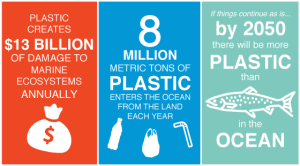Can We Win the Battle of Plastic Pollution?
Oct 24th, 2018 | By admin | Category: Consumption and WasteBy Candela Vázquez Asenjo, youth blogger for Transition Earth.
I have been an activist campaigning against plastic pollution for the past four years. During this time, I have learned about a number of projects that promised to change the course of plastic pollution, but sadly none have actually been strong enough to have a lasting impact. There is one, however, that I believe stands an excellent chance to make a difference for the better.That project that has good potential to change humanity’s wasteful plastic use is The Ocean Cleanup.
In its relatively short existence, The Ocean Cleanup has garnered a lot of attention. Many people have formed opinions, with some thinking this is a wasteful endeavor and others that believe it is our oceans’ salvation.
Therefore, it is important to take a closer look on why is there so much discrepancy about this new initiative.
It is quite possible you have already heard about The Ocean Cleanup. It was founded by Boyan Slat, a young 24-year-old Dutch inventor, who has captured the attention of many people from a variety of sectors with his bold project.
Five years ago, Slat decided that in order to successfully remove plastics from the world’s oceans, he needed to create a system where the plastics could be easily removed. His beta cleanup system is a 600 meter long floater with a 3 meter deep membrane where the plastic will be caught while allowing marine fauna to swim below it. This is due to the membrane creating a downward blow where marine life can safely pass beneath it.
This system will collect around five tons of ocean plastic per month in the Great Pacific Garbage Patch. The plastic “caught” will be collected and emptied every four to six weeks.
This beta system is call “System 001” and its purpose is to clean up to 50% of this patch in five years, with a 90% reduction by 2040. To make this goal have an impact, 14,000 tons per year would have to be collected. The total cost of the “System 001” is about 21 million euros (US $24.6 million), which includes design, development, production, assembly and monitoring during the first year in operation.
Once the plastic refuse is collected from the ocean, it will be turned into recycled plastic products. In the meantime, until this beta system has been proven successful, it will be used to measure and collect informational behavior about its potential damages, along with monitoring climate and wave information to see if the machine works well in the open ocean.
There are some disadvantages to Slat’s system. First, not all plastics in the garbage patch are on the surface, with the majority found at deeper levels. Second, there is no guarantee that the plastic-catching membrane will not trap fish or other ocean species. Slat has said that this first six-month trial will show if the membrane affects the marine ecosystem.
Some experts have noted that this project is like placing a bandage on a wound, meaning that is a short term solution but it will not do much unless we decide to stop producing high quantities of plastic and continue to waste much more of it. There is a theory corroborated by neuroscience that says recycling, or knowing there is a solution to our waste, makes people feel good and care less about how much waste has been produced. If that occurred, it would mean an increase in the amount of plastics sent to landfills or the oceans, lakes and rivers
Still, there is a good possibility that this project could actually reduce plastics in the ocean. Slat has set very high goals to achieve success, saying that “The Ocean Cleanup” team would be able to extract 50% of the plastics from the Great Pacific Garbage Patch every five years.
My skepticism comes from the fact that many scientists have said that not all plastics are on the surface, but also found on the world’s beaches or deep in the ocean.
At the same time, we should consider that by extracting 50% of ocean plastics also means that more plastics are still ending up in the ocean every day, month and year. Nearly 150 million tons of plastic are already found in the ocean. Every year, 310 million tons of plastic are produced, with 8 million tons going into the ocean – the equivalent of a truckload of plastic being dumped into the ocean every minute. These figures will double in 2030 and quadruple in 2050.
However, this project should be seen as the starting point of something new, a change in the behavior of people, governments, and businesses that have decided to help reduce in some way the amount of plastics in the ocean. It is an effort beyond just studying the impact and consequences.
This will not be the end point on reducing of plastics on the planet, but it is the first time that a machine of this proportion has been introduced in the ocean. It is a change on a massive scale to mitigate the impacts of plastic in the marine ecosystem.
Of course much more has to be done, but for the time being, this project has helped to change minds by showing where the problem exists. Perhaps most importantly, it is raising awareness about an enormous problem that many people unfortunately still know little about, and that may have the biggest impact.
Candela Vázquez Asenjo is a recent graduate of the University of Manchester, UK, with a degree in Environmental Management. She has also earned a law degree from Nebrija University in Spain. She is a social entrepreneur, with a focus on international environmental problems.

![[Photo: singularityhub.com]](http://populationgrowth.org/wp-content/uploads/2018/10/garbage-plastic-pollution-ocean-cleanup-556842991-1068x601-300x169.jpg)

![[Photo: Image Credit: Erwin Zwart / The Ocean Cleanup]](http://populationgrowth.org/wp-content/uploads/2018/10/The-Ocean-Cleanup-trash-300x169.jpg)
